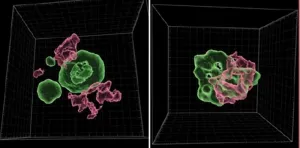An analysis published in the Journal of Heart & Lung Transplantation showed significant inequity in lung transplant access based on these candidate characteristics and proposes a method for addressing it.
Lung transplant candidates require organs from donors of similar height and compatible blood type. Currently, to allow equally sick candidates equal access to transplant in the United States, the lung allocation system ranks candidates using a Composite Allocation Score, which includes a biological disadvantage subscore. This subscore provides additional points to those with shorter stature and harder-to-match blood types.
Analyzing data for adult lung transplant candidates and donors across the U.S., Cleveland Clinic and CWRU researchers have developed an alternative scoring system for the blood type and height components of the Composite Allocation Score’s biological disadvantage subscore. The approach projects the supply of compatible organs for a given candidate based on the individual’s combination of characteristics. The team then used a new simulation model, which it recently developed and validated, to assess the expected impact of implementing this proposed solution for U.S. patients on the lung transplant waiting list.
While the current Composite Allocation Score considers the effects of blood type and height independently, the research team’s approach of considering blood type and height-based disparities simultaneously provides a more holistic evaluation of biological disadvantage, as candidates can have any combination of these biological characteristics.
“This approach may result in decreased organ waitlist mortality and increased transplant rates overall,” said Maryam Valapour, M.D., M.P.P., pulmonologist at Cleveland Clinic and co-senior author of this research with Jarrod Dalton, Ph.D., Lerner Research Institute, Cleveland Clinic.
“It also better mitigates the compounding biological disadvantages stemming from hard-to-match combinations of blood type and height,” said Dr. Dalton.
Candidates with type-O blood encounter a disadvantage that stems from the fact that they can only accept organs from type-O donors, while type-O organs are compatible for candidates of any ABO blood type. Controlling for height and patients’ medical urgency, the analysis found that type-O candidates had a 37% lower rate of transplant compared with type-A candidates under the current system.
The height difference between donor and candidate is also an important consideration for surgical feasibility in lung transplantation. The relationship between lung transplant candidates’ height and waitlist outcomes is well established, reflecting the relative lack of very tall or very short donors. For example, a candidate who is 5’9” has a 61% higher likelihood of accessing a transplant compared with a candidate who is 5’3.”
“This is a central mechanism for the long-observed sex disparity in lung transplant, as women tend to be shorter in stature than men, e.g. 25% of women are 5’3” or shorter compared to only 1% of men,” said Dr. Valapour.
“While recent policy changes and discussions have focused heavily on blood type-based disparities, our analysis indicates that height extremes likely result in a greater disadvantage than previously understood and have not been sufficiently addressed in the current system,” said Johnie Rose, M.D., Ph.D., CWRU School of Medicine associate professor and co-first author of this research.
“Addressing policies on disparities related to blood type and height will help us move closer to achieving equitable access to lung transplantation in the United States,” said Dr. Valapour.
Next, researchers will conduct work to optimize the weighting given to biological disadvantage Composite Allocation Score components. Eventually, this approach could be applied to allocation of other transplanted organs.
This project was funded by the National Heart, Lung, and Blood Institute of the National Institutes of Health (R01HL153175).
###
About Cleveland Clinic
Cleveland Clinic is a nonprofit multispecialty academic medical center that integrates clinical and hospital care with research and education. Located in Cleveland, Ohio, it was founded in 1921 by four renowned physicians with a vision of providing outstanding patient care based upon the principles of cooperation, compassion and innovation. Cleveland Clinic has pioneered many medical breakthroughs, including coronary artery bypass surgery and the first face transplant in the United States. Cleveland Clinic is consistently recognized in the U.S. and throughout the world for its expertise and care. Among Cleveland Clinic’s 77,000 employees worldwide are more than 5,658 salaried physicians and researchers, and 19,000 registered nurses and advanced practice providers, representing 140 medical specialties and subspecialties. Cleveland Clinic is a 6,699-bed health system that includes a 173-acre main campus near downtown Cleveland, 23 hospitals, more than 275 outpatient facilities, including locations in northeast Ohio; southeast Florida; Las Vegas, Nevada; Toronto, Canada; Abu Dhabi, UAE; and London, England. In 2022, there were 12.8 million outpatient encounters, 303,000 hospital admissions and observations, and 270,000 surgeries and procedures throughout Cleveland Clinic’s health system. Patients came for treatment from every state and 185 countries. Visit us at clevelandclinic.org. Follow us at twitter.com/ClevelandClinic. News and resources available at newsroom.clevelandclinic.org.
Editor’s Note: Cleveland Clinic News Service is available to provide broadcast-quality interviews and B-roll upon request.
About Case Western Reserve
At Case Western Reserve, one of the nation's leading research universities, we're driven to seek knowledge and find solutions to some of the world's most pressing problems. Nearly 6,200 undergraduate and 6,100 graduate students from across 96 countries study in our more than 250 degree programs across arts, dental medicine, engineering, law, management, medicine, nursing, science and social work. Our location in Cleveland, Ohio—a hub of cultural, business and healthcare activity—gives students unparalleled access to engaging academic, research, clinical, entrepreneurial and volunteer opportunities and prepares them to join our network of 125,000+ alumni making an impact worldwide. Visit case.edu to learn more.
END






